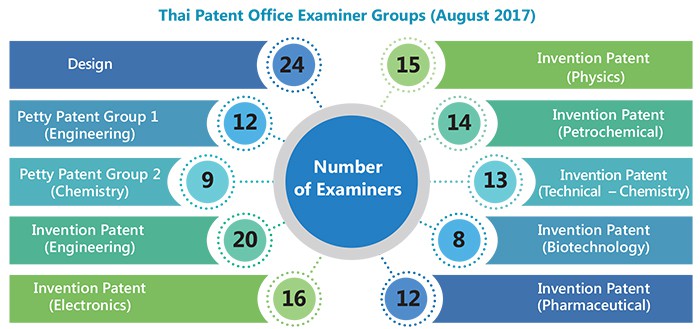The problem of long periods of pendency for patent registration in Thailand may finally be successfully solved after several past attempts, even though an expected executive order under section 44 of the nation’s interim constitution has not yet been formally announced.
The Thai Department of Intellectual Property (DIP) has put forward great efforts in setting up an effective action plan and has substantially increased its Patent Office manpower in 2016 and 2017, in order to effectively and promptly examine pending patent applications. The number of patent examiners in each examiner group has increased more than 100 percent, with the total number of examiners growing from 39 in 2015 to 143 in August 2017. The approximate headcount of each examiner group at the Patent Office is as follows:

With the increase in patent examiners, the current DIP patent registration process is proceeding at a much faster pace. From October 1, 2015, to September 30, 2017, the Patent Office has published 24,288 patent applications and 7,926 design patent applications. During the same time period, it has also granted 7,299 patents, 8,027 design patents, and 3,735 petty patents, or about 1.39 times the total average of 13,687 per year for patent, design, and petty patent applications in the past five years (2012–2016) (shown in table 1).
The increase in examiners is a step in the right direction to solve the long-standing problem of how to clear the huge backlog of applications pending for an inordinate amount of time in the patent prosecution process. With the greater output from the increased Patent Office manpower, it is advisable for local representatives to keep pace by managing and increasing their own resources to handle the expected influx of office actions from the Patent Office and prevent backlogs from accumulating.
With the improvements in the DIP’s application-to-patent-examiner ratio, it remains to be seen whether the increase in productivity rates will contribute to an increase in patent registrations. If the issuance of office actions continue at present rates, it is likely that the DIP may be able to register intellectual property rights within the parameters set out by the Licensing Facilitation Act B.E. 2558 (2015), which prescribes the time to register an invention patent to be within 55 months, design registration to be within 15 months, and petty patent registration to be within 3 months.

This is positive news for Thailand as the registration of intellectual property can be completed in a more timely and predictable manner, which will serve to attract investments in technology into the kingdom and contribute to the government’s “Thailand 4.0” policy.
